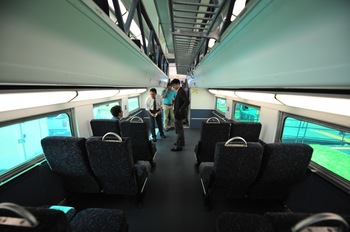A common refrain heard among people in Michigan is that trains are uneconomic and a sinkhole of costs and no profit. The facts are more nuanced. Some commuter trains firms are profitable and some are loss making. In many countries, railroads are a "for profit" activity. People forget that all railroads in the U.S. were built with private risk capital. The Japanese high speed rail system (they started building it in 1962 when "Made In Japan" was a byword for cheap plastic crap) was privatized and that company was sold for $90 billion to private investors.
What most people don't realize is that the Detroit to Chicago "higher speed" rail line, now fully funded, once in service in 2015 or 2016 will be a very profitable business earning tens of millions of dollars a year in profit based on the most recent (very reasonable) feasibility study available. Delta and Southwest earn substantial profits on their Detroit to Chicago air shuttle service and this will be a cheaper and faster way to get to Chicago.

A look inside the double-decker railcar is toured by visitors at the 2013 Ann Arbor MAyor's Green Fair.
Ryan J. Stanton | AnnArbor.com
The revenue improvement is also realistic because higher speed trains will shift business travelers like me from planes to trains. By the time I drive to the airport and park, go through security and wait, I've blown 90 minutes and on the other end 30-90 minutes depending upon which airport, where I am actually going and if it is rush hour or not. The elapsed time taxiing and flying is about 60 minutes, so 3 hours to 4 hours. Including the parking fees ($10 or $20 a day, but add 15 minutes to the trip if you use the $10 lot), car mileage ($25), taxi ($30) or mass transit costs ($3) on the other end and the plane ticket itself ($265 to $800 depending upon how far in advance you buy your ticket and which airline you use), air travel costs ($303 to $875) a lot more than the projected round-trip price of $90-$120. What's the advantage in air travel then?
The key is that the higher speed rail has to be reliable and on-time +90% of the time, like the best airlines are. Then passengers would migrate en mass and adding more train cars to an already moving train is cheap, so the extra marginal revenue from those passengers will be very, very profitable.
If it was a stock, I'd be buying it. However due to a federal law called PRIIA, the current $17 million annual loss on the line for the next two years until the higher speed trains run and the service turns profitable must be borne by the state of Michigan and the state legislature is balking at funding it. Maybe the governor should do an initial public offering to raise the money?! If he raised $50 mm privatizing the ownership of the operating route in Michigan in an IPO and in 2015 it earned $18 mm, it would be a great investment! In other words an entity that owns the land hires Amtrak to operate the higher speed rail line and pays any deficits and gets to keep any operating profit. It would still be branded Amtrak.
It's not possible without legislation at the state and federal level, but my reason for raising it is as a thought exercise to show that it is a profitable business and a wise investment for the state to make. This profitable rail business could then fund the start-up costs of commuter shuttle trains.
If the Canadians build out a similar service to Toronto from Detroit, as Governor Snyder is currently trying to do, the economics get better again. This would further improve ridership and the profitability of the "higher speed" rail line. Over time, we can funnel the profits from running this 110 mile per hour service into true high speed rail with speeds of 250 m.p.h. Then you would be able to go from downtown Ann Arbor to Chicago or Toronto in one hour and fifteen minutes or to downtown Detroit in under 15 minutes.
(Stephen Lange Ranzini is president of University Bank and resident of downtown AnnArbor. He's also an occasional columnist on AnnArbor.com.)